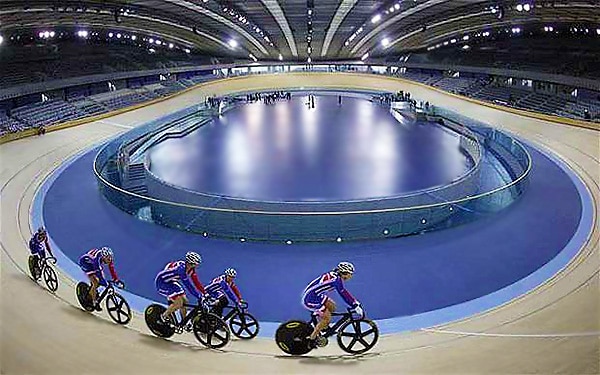What is the London Olympics Velodrome?
The London Olympics Velodrome refers to the velodrome cycling track that was built for the 2012 Summer Olympics held in London, United Kingdom. The velodrome is an indoor track cycling venue located in the Olympic Park in Stratford, East London. It was one of the key venues used during the London Olympics and Paralympics.
The London Velodrome was designed by Hopkins Architects and constructed between 2009 and 2011. It has a distinctive curved shape and a unique roof design that is intended to reflect the shape of a cycling helmet. The design was praised for its sustainability features, including natural ventilation and rainwater harvesting systems.
During the 2012 Olympics, the Velodrome hosted track cycling events, including various disciplines such as sprint, team pursuit, keirin, and others. After the Olympics, the venue became a popular cycling facility for both elite athletes and the public, hosting various national and international cycling competitions and offering facilities for recreational cyclists.
It’s worth noting that there may have been further developments or changes to the Velodrome or its use since my last update, so I recommend checking more recent sources for the latest information.
What is the significance of the architecture design of the London Olympics Velodrome?
The architecture design of the London Olympics Velodrome holds significant importance for several reasons:
- Iconic and Recognizable Symbol: The velodrome’s design, characterized by its distinctive double-curved roof, has become an iconic symbol of the 2012 Summer Olympics and the broader Olympic Park. Its unique and recognizable silhouette has contributed to the visual identity of the event.
- Aesthetic Appeal: The velodrome’s architectural design is aesthetically appealing, blending form and function seamlessly. The sleek lines, curved roof, and overall modern design contribute to a visually striking and memorable structure.
- Sustainability and Environmental Responsibility: The velodrome’s design incorporates sustainable features, aligning with the growing emphasis on environmentally responsible architecture. From rainwater harvesting to natural ventilation and energy-efficient lighting, the venue showcases a commitment to sustainability.
- Optimized Performance: The design of the cycling track, the Siberian pine wood surface, and the precise 42-degree banking of the bends are all elements carefully considered to optimize the performance of cyclists. The venue’s design enhances the experience for both athletes and spectators during cycling events.
- Acoustic Considerations: The curved roof of the velodrome serves a functional purpose in controlling noise and optimizing acoustics. This is particularly important in creating an atmosphere conducive to high-performance cycling events, where focus and concentration are crucial.
- Legacy and Adaptive Reuse: The design allows for adaptability and flexibility, ensuring that the venue can be repurposed for various events beyond the Olympics. This adaptability contributes to the lasting legacy of the velodrome, as it continues to be a valuable asset for the community.
- Integration with Surroundings: The velodrome’s design integrates seamlessly with the surrounding landscape and the overall architectural plan of the Queen Elizabeth Olympic Park. Its placement and design contribute to the park’s overall aesthetic and functionality.
The significance of the architecture design of the London Olympics Velodrome lies in its visual impact, sustainability, performance optimization, adaptability, and contribution to the broader legacy of the Olympic Games and the host city.
A Look Into The London Olympics Velodrome
With 2012 rounding the corner, there is a lot to come within such a milestone year: ranging from the Presidential race to the possible end of the world to the 2012 Olympic games.

London Olympic Velodrome
Set to take place in London, the structures and athletic arenas have been in the work for quite some time, and with the fully completed Velodrome, which opened in February of 2011, the architectural trends for the games have shown a constant evolving design trend throughout the games’ history.

Velodrome London Olympic
The Velodrome designed by Expedition Engineering is the games’ most eco-friendly and sustainable building for the 2012 Olympics. The green design of the structure with its steel reduction use in design along with energy and water reduction is a modern marvel that will withstand the test of time.
Located in the glorious structure which houses 6,000 seats and is geared towards the cycling events of the games, lies a grandiose piece of modern design that boasts innovation in sustainability and modern interior design.

Olympic Velodrome London
Its wooden façade is a true marking of eco-friendly design by using natural elements on the outside as well as the inside. The Velodrome marks yet another step into the value of sustainability and it prominence in the future of architecture. We’re excited to see how this landmark will come to use for the Olympic games mid-year in 2012 and how the Velodrome will serve as a beacon of green building for years to come.
What are some of the most impressive features of the London Olympics Velodrome?
The London Olympics Velodrome, built for the 2012 Summer Olympics, is renowned for its impressive design and features:
- Architectural Design: The velodrome’s design, by Hopkins Architects, is striking and iconic. Its double-curved roof is not only aesthetically pleasing but also serves functional purposes, optimizing natural ventilation and providing ample daylight.
- Sustainability: The velodrome was designed with sustainability in mind. It features a rainwater harvesting system, natural ventilation, and a low-energy lighting system, making it an environmentally friendly structure.
- Optimized Cycling Track: The cycling track inside the velodrome is made of Siberian pine wood, known for its smooth surface and durability. The track is banked at 42 degrees on the bends, allowing for high-speed cycling and providing an exciting experience for both athletes and spectators.
- Acoustic Design: The velodrome’s unique design includes a curved roof that helps control noise and optimize acoustics. This is crucial for maintaining a focused and immersive atmosphere during cycling events.
- Capacity and Flexibility: The venue has a seating capacity of approximately 6,000 spectators. The flexible design allows for easy conversion, making it suitable for various events beyond cycling, such as concerts and exhibitions.
- Integration with Surroundings: The velodrome is situated in the Queen Elizabeth Olympic Park and is seamlessly integrated with its surroundings. It has become a key element of the park’s legacy, contributing to the regeneration of the area.
- Legacy and Continued Use: After the 2012 Olympics, the velodrome continues to be used for various cycling events, both competitive and recreational. Its legacy includes promoting cycling as a sport and providing a world-class facility for athletes.
These features collectively make the London Olympics Velodrome a standout venue, not just for its role during the Olympics but also for its lasting impact and functionality.
This architecture blog was published by Nazmiyal Antique Rugs in New York City



